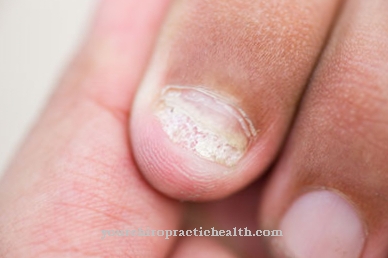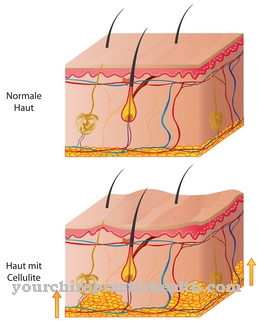Hepatitis E. is a form of liver inflammation caused by a virus. It is atypical for Europe and occurs mainly in Asia, Central and South America as well as Northeast and North Africa.
What is hepatitis E?

© Alila Medical Media - stock.adobe.com
Hepatitis E is an acute inflammation of the liver. The cause is the hepatitis E virus. It attacks the liver cells and is responsible for functional disorders of the organ.
While hepatitis E is almost unknown in Europe and is largely considered a travel sickness, hepatitis E epedemics occur again and again in North Africa, Central and South America, India, Sudan and Iraq.
Apparently younger people (under 20 years of age) rarely or very rarely develop hepatitis E. Hepatitis E was first detected in 1980.
causes
Hepatitis E occurs especially where food is contaminated or drinking water is contaminated with faeces. The virus mainly enters the body through food intake.
Smear infections are also a possible type of infection, while infection through droplet infection has not been proven. It is also believed that the virus can be transmitted to the unborn child.
People in the floodplains of the corresponding regions are particularly likely to get sick during the monsoons, as the pathogen is transmitted through water to both humans and animals. Mammals such as mice, rats, pigs, sheep and monkeys are among the natural hosts of the virus. Therefore, eating the meat of an infected animal can also lead to disease.
Symptoms, ailments & signs
Hepatitis E is a viral disease of the liver that is very similar in its course to hepatitis A. As with this, unspecific symptoms appear initially, which can also indicate other diseases. These symptoms include nausea, vomiting, fever, and flu-like symptoms. In the further course, jaundice can also occur.
This is indicated by yellowing of the skin and eyes as well as unbearable itching. In addition, the stool often becomes discolored, which then takes on a light color. At the same time, the urine becomes dark in color. However, not all sufferers develop jaundice. A completely asymptomatic course of the disease is often possible. Hepatitis E usually heals on its own without consequences.
However, there are also more complicated processes. Hepatitis E is particularly dangerous for pregnant women. If the disease occurs in the last trimester of pregnancy, it can develop into a fulminant course with liver failure and acute pancreatitis, which is fatal in up to 20 percent of cases.
Serious and sometimes fatal complications can also occur in people with liver damage or immunocompromised disorders. Overall, however, apart from pregnant women, complications and deaths from hepatitis E are very rare. As a rule, there are no chronic courses either, with the exception of organ transplant people, in whom, in very rare cases, chronic cases have also been observed.
course
An incubation period of 30 to 40 days applies to hepatitis E. The disease usually begins with unspecific symptoms that do not differ from those of hepatitis A. These include fatigue, tiredness, loss of appetite, fever, nausea, weight loss, headache, feeling of pressure in the upper abdomen, as well as muscle and joint problems.
After that, the usual symptoms of jaundice appear. The urine turns dark, the stool is discolored, the skin or eyes turn yellow, and in some cases severe itching occurs.
After about six weeks, these symptoms will go away on their own. Hepatitis E in children is very often symptom-free. Because of the same clinical course as hepatitis A, hepatitis E can only be reliably detected by a blood test and the presence of antibodies.
Complications
Hepatitis E is a rather harmless hepatitis. Once infected, it heals again after a few weeks without any consequences. This is especially the case in people with an intact immune system. If the immune system is inadequate, the patient can slide into liver failure.
The liver can no longer perform its important tasks and serious consequences arise. On the one hand, not enough proteins are produced that are required. This leads to strong water retention in the body, the edema. Also, fewer proteins for coagulation are synthesized, the bleeding time is extended and there is a risk of bleeding in the event of serious injuries.
The liver's detoxification function is also disturbed. Ammonia builds up in the body, which can lead to hepatic encephalopathy in the brain. Furthermore, the blood is no longer transported properly through the liver. It is derived more in bypass loops. These are located on the stomach, esophagus, and rectum.
Varicose veins on the stomach or esophagus and hemorrhoids are the consequences. Death due to hepatitis E infection has been observed in pregnant women in particular. About 20 percent of pregnant women with hepatitis E die from the disease.
When should you go to the doctor?
With hepatitis E there is no self-healing and in the worst case the disease leads to the death of the person concerned. A doctor should be consulted at the first signs of the disease. It should also be noted whether the person concerned has been in an affected area in the past few weeks. See a doctor if the patient suffers from jaundice. Usually this is easy to recognize from the outside. It is accompanied by weakness and fatigue.
Weight loss or loss of appetite are also signs of hepatitis E and should be investigated. Many patients also experience severe pain in the abdomen and head, but these are not particularly specific symptoms. The onset of hepatitis E is very similar to a common cold. A doctor should be seen at the latest when the jaundice occurs.
Since hepatitis E must be reported, the disease should be treated in a hospital. Alternatively, the person concerned can also contact a general practitioner. An early diagnosis has a positive effect on the further course of the disease.
Doctors & therapists in your area
Treatment & Therapy
In hepatitis E, only the symptoms that accompany the disease can be treated. There is no vaccine against the disease.Since it is a viral disease, the use of antibiotics does not make sense either.
Bed rest and pain relievers if necessary are usually prescribed. Alcohol should be avoided so as not to put additional strain on the liver. In most cases, hepatitis E heals on its own and proceeds without complications. Serious disease courses up to and including death are extremely rare, but can occur in pregnant women in the last trimester of pregnancy.
In these cases, hepatitis E can lead to acute liver failure and acute inflammation of the lungs, heart or pancreas. Hepatitis E is always acute, chronic diseases are not yet known.
If there is suspicion of hepatitis E, an existing illness or a death, the treating doctor must be reported in accordance with the Infection Protection Act, since the illness is notifiable.
Outlook & forecast
The prognosis for hepatitis E can be classified as favorable. In contrast to the other forms of hepatitis, the course of the disease is not chronic. The symptoms that arise are minor in direct comparison to the other courses of the viral disease.
In almost all documented cases, the patient fully recovered after a few weeks of infection. The slight complaints usually heal independently and without medical help. Treatment is therefore usually not required. In addition, no consequential damage or permanent impairment is to be expected from hepatitis E disease. This also applies if the disease breaks out again.
In rare cases, the disease progresses seriously with a fatal outcome. The dramatic developments only affect patients who belong to a risk group. Pregnant women who are in the last trimester of their pregnancy have a very poor prognosis. They can have a sudden and unexpected premature birth.
This is associated with the usual dangers for the newborn and, in addition to life-long health impairments, can also lead to the death of the child. In addition, pregnant women can miscarry. In particularly severe developments, the mother-to-be dies. In 1/5 of all known cases, the pregnant woman does not survive the consequences of hepatitis E.
prevention
A preventive vaccination against hepatitis E is not possible because research is still being carried out on a vaccine. When traveling to countries where there is a possibility of infection, hygienic measures in particular can help to protect yourself against hepatitis E.
Basically, only boiled water or packaged mineral water should be drunk and used. It is also recommended that fruits and vegetables be rinsed and brushed thoroughly with boiled water. If this is not possible, it should only be used in peeled form.
The consumption of food from snack stands is classified as questionable. Corresponding information on endangered areas can be obtained from the Federal Foreign Office or from any tropical institute. If you suspect a disease, you should definitely consult a doctor.
Aftercare
In order to heal the disease as completely as possible and to prevent further incidents, a gentle lifestyle should be sought. Alcohol consumption should be curbed if possible. Smoking also damages the liver, which is already overworked by the disease.
Medicines that affect the liver, such as paracetamol, should only be taken sparingly, rarely, and only after medical advice. Hormonal contraceptive medication can also put additional strain on the liver. Therefore, the previous hepatitis E disease should be pointed out before taking it. In addition, sport and strenuous activities should be avoided until the disease has completely healed.
Bed rest is not compulsory, but it makes sense depending on your needs and condition. With regard to nutrition, a liver-sparing diet should be aimed for. This means that foods rich in fat should be avoided and instead switched to foods rich in carbohydrates. Fatty sausage and fatty meat are particularly tricky and therefore not to be consumed.
In addition, to avoid further hepatitis E outbreaks, meat intended for consumption should always be sufficiently cooked. Restricted sugar consumption has been shown to promote healing. Because too much sugar is converted into fat in the body, which is harmful to the liver. On the other hand, omega-3 fats such as linseed oil are particularly good for the liver. A regular blood count to clarify the liver values is also part of a careful follow-up.
You can do that yourself
Hepatitis E is extremely rare in Europe and is considered a motion sickness. This form of hepatitis is particularly widespread in Southeast Asia, Iraq and Sudan. In Asia, most cases of disease occur during the monsoons. Private trips to Southeast Asia should therefore be undertaken at a different time of the year.
A number of precautionary measures can be taken for those who travel to high-risk areas for work. Hepatitis E pathogens enter the body mainly through food intake. Drinking water and food contaminated with faeces are particularly dangerous. Since the disease can be transmitted not only from person to person but also from mammals, especially rodents, pigs, sheep and monkeys, the meat of these animals should not be consumed.
In addition to being infected by contaminated food, there is also the risk of smear infection. Regular, thorough hand washing can have a preventive effect here. In addition, everyday objects such as pens, cell phones or computer keyboards should not be shared.
If you have to use an internet café, you should disinfect the keyboard and mouse, never touch your face or mouth while working and clean your hands very thoroughly immediately afterwards.
Since a hepatitis E infection leads to an acute illness less often in people with an intact immune system and this usually heals quickly and without problems, a healthy lifestyle also contributes to self-help.

.jpg)











.jpg)

.jpg)
.jpg)











.jpg)